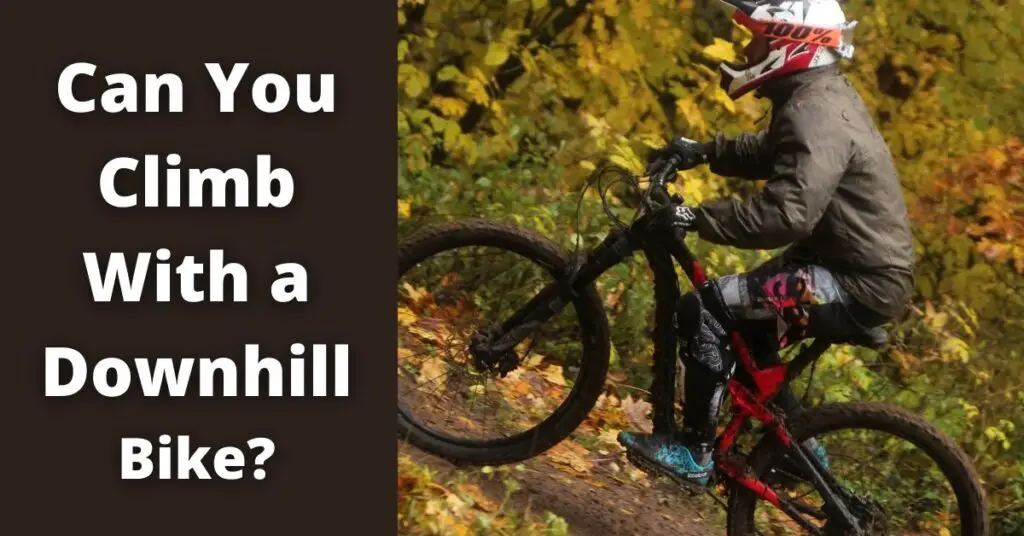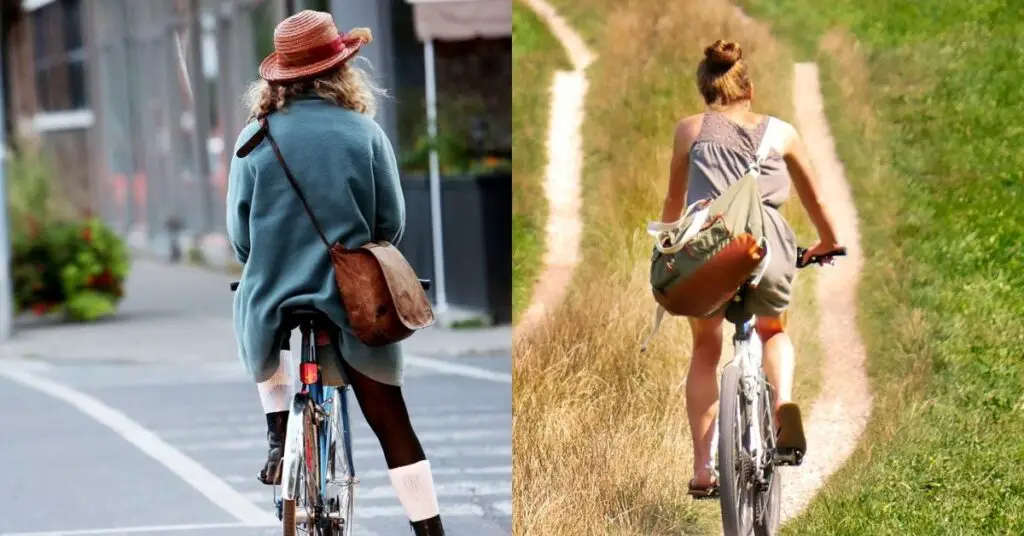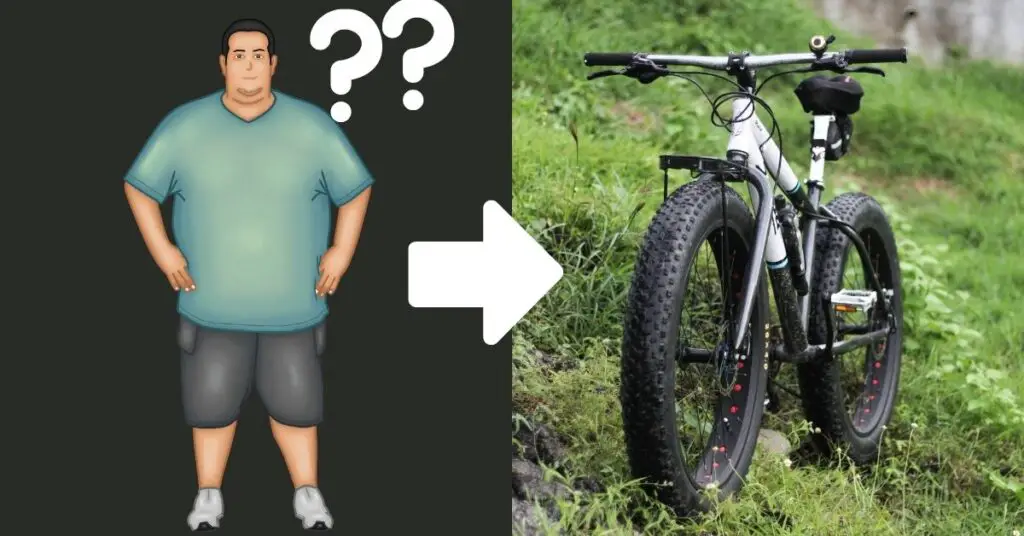Downhill bikes are popular among riders that ride on rough terrains and prefer stronger frames because these bikes are built to withstand a lot of punishment and have increased travel.
The main purpose of downhill bikes however and what they are popularly known for is their ability to descend steeps and hills at high speed.
Downhill bikes come with few gears and 1 chainring that is specially built for downhill races but does that mean they can’t be used to climb?
In this article, we’ll be looking at downhill bikes and discussing the possibilities of climbing with them; how doable it is, and how hard it could be. We’ll also be giving tips on how to go uphill without necessarily losing strength or energy.

Can You Climb With a Downhill Bike?
Climbing with a downhill bike is not advisable. You can do it if you’re a strong rider and do not have to climb a lot but it will take a great deal out of you.
This is because downhill bikes aren’t built for climbing. They are built to go downhill fast and that’s period. Using a downhill bike for anything other than that is a disaster.
Even if you’re a strong rider, you would most probably injure yourself if you climb often with a downhill bike. Your joints would start hurting and may even feel pain all over your body.
How Hard Is It to Climb With a Downhill Bike?
Climbing with a downhill bike is very hard. You will have to struggle hard as it is difficult to pedal going uphill and you may have to push your bike up every time. The weight makes it especially difficult to handle.
Here are the reasons why it is Hard to Climb with Downhill Bikes:
1- Components
Downhill bikes come with very strong frames, big wheels, and sturdy tires. This is because these special features help the downhill bikes to absorb shocks well and keep them from getting damaged. This is an advantage if you ride on rough terrains and also have to go downhill at very high speed.
But when it comes to climbing, they aren’t much of an advantage. They are in fact the reasons they can’t be used to climb.
2- Saddle Design
Also, downhill bikes come with very low saddle positions which aren’t designed to move up. This is good for descents but makes climbing harder and quite a struggle.
These Tips will Make Your Climbing Easy
If you are determined about climbing with a downhill bike and don’t mind spending a bit, you can try doing these few things.
1- Add More Gears
One of the reasons downhill bikes can’t climb is because of their gears. They come with few gears that are just enough for descending.
Get a cassette with more cogs, thinner chains, derailleurs that match the new cassette, and shifters with more clicks to match the derailleurs.
You could also change the cassette to another with the same number of gears but with more jumps between the gears. This will give you a wider range of gears and help you to climb easier.
2- Change Wheels
Get lighter wheels and tires that would lighten the bike and make it easier to climb with. You may also have to raise the seat up, to give you a better climbing position.
What Gear Is Best for Going Uphill on a Bike?
The best gear for going uphill on a bike is the “easier gear”. This is achieved by shifting the chain onto your smallest chainring in the front and onto the biggest cog in your cassette.
If you’re using triple chainrings, the middle one will work fine too. It all depends on what works for you. Use any of your two smaller chainrings and decide which one helps you climb faster.
You might not necessarily use the biggest cog too, but it has to be one of the bigger cogs in your cassette. This makes pedaling easier and puts you in a comfortable position.
Your left shifter is for shifting in the front and the right shifter is for shifting in the rear.
How to Successfully Climb a Hill?
If you’re new to climbing or going uphill, climbing hills can be scary or look impossible but it doesn’t need to be. There are steps you can follow which will make it easier and achievable.
1- Change to an Easier Gear
This is the first step and we’ve explained how to do that in detail. Your type of bike doesn’t matter as it applies to all bikes.
2- Build Up Speed
This is necessary to take the hill without fear.
As you approach it, build up just a little speed to help you get started. Don’t go too fast because you don’t want to tire yourself before reaching the peak. As you climb the hill, you can increase your speed at intervals until you reach the top.
If you hit the hill too hard and too fast, you will use up your energy before you finish climbing the hill and may find yourself gasping for breath.
3- Maintain an Adequate Cadence
For you to successfully climb a hill, there must be unity between your cadence and gearing. Cadence is how you measure the number of times you turn your pedals per minute.
You will need to establish and maintain a cadence of about 75-95 rpm(revolution per minute) to climb a hill. Maintaining that cadence on your easier gears will help you climb the hill faster.
4- Climb That Hill in Your Head
Sometimes what’s holding you back is only in your mind. It is “unfounded fears”. It always helps when you focus on the hill and climb it first in your head.
Once you’ve climbed the hill mentally, it’s easy to do it physically following the previous steps.
How to NOT Get Tired While Going Uphill on Your Bike?
Now that you know how you can climb without problems, how do you do it without getting tired?
Maybe you stay in an area where you can’t avoid climbing hills all the time, and it often leaves you exhausted, here are a few tips to help you avoid that.
1- Avoid Climbing With Heavy Bikes
The heavier your bike, the harder it will be to climb and the faster you’ll get exhausted. Lighter bikes are best for climbing because they are easier and will help you climb faster without sapping your strength.
If your bike is heavy, try replacing its wheels and tires with lighter ones. It will make a difference. Carry only as much load as you need.
2- Shed Some Weight
Most often than not, light riders climb faster and easier than heavy riders.
Your weight can make it harder for you to climb and you’ll often get tired while climbing. So exercise and try to lose a few pounds. It will also keep you fit and help your health.
3- Use the Right Bike
Make sure you’re climbing with the appropriate bike. You’ll often get tired if you climb with a bike that isn’t meant for climbing.
For example, climbing hills and going for uphill races with a downhill bike will not end well because downhill bikes aren’t meant for climbing and you’ll only tire yourself trying to climb with them. However, Enduro Bikes are good for climbing hills.
4- Stay Hydrated
Dehydration can often make you tired while climbing hills. You should avoid this.
Get a bottle of water and take it along as you climb. Hydrate as often as possible to renew your energy and keep your strength.
You can also take an energy bar or a carbohydrate snack before climbing.
5 Train
Train your muscles, build up your endurance and climb as often as you can. Practice climbing all the time.
You won’t get the hang of climbing just after your two climbs. It will only get easier as you continue climbing.
6- Maintain Your High Cadence
It’s often tempting to reduce your cadence as you climb because you’re tired or prefer to slow down but don’t do it.
Maintain that cadence and continue that momentum. Slowing down will only get you tired and make the climb more difficult.
Which Bike is Good for Climbing?
If you want a multi-purpose bike that can climb easier and also can be used to descend at an adequate speed, you should go for Enduro bikes.
They are quite strong too and you won’t break bones trying to climb with them.
It can also be cheaper than changing wheels and gears on your downhill bike to make it climb.
Final Thoughts!
Downhill bikes aren’t meant for going uphill so it’s difficult to climb with them. But it can be done if some of their key components are replaced. It will not climb as well as other bikes that are built for climbing but it will get you up that hill.
Climbing hills doesn’t have to be difficult if you do it properly and we’ve discussed the ways you can do that. Pay attention to those tips carefully and you won’t have to find climbing a grind.
Cheers!




